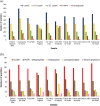Peptidomic and glycomic profiling of commercial dairy products: identification, quantification and potential bioactivities
- PMID: 31304276
- PMCID: PMC6550233
- DOI: 10.1038/s41538-019-0037-9
Peptidomic and glycomic profiling of commercial dairy products: identification, quantification and potential bioactivities
Abstract
Peptidomics and glycomics are recently established disciplines enabling researchers to characterize functional characteristics of foods at a molecular level. Milk-derived bioactive peptides and oligosaccharides have garnered both scientific and commercial interest because they possess unique functional properties, such as anti-hypertensive, immunomodulatory and prebiotic activities; therefore, the objective of this work was to employ peptidomic and glycomic tools to identify and measure relative and absolute quantities of peptides and oligosaccharides in widely consumed dairy products. Specifically, we identified up to 2117 unique peptides in 10 commercial dairy products, which together represent the most comprehensive peptidomic profiling of dairy milk in the literature to date. The quantity of peptides, measured by ion-exchange chromatography, varied between 60 and 130 mg/L among the same set of dairy products, which the majority originated from caseins, and the remaining from whey proteins. A recently published bioactive peptide database was used to identify 66 unique bioactive peptides in the dataset. In addition, 24 unique oligosaccharide compositions were identified in all the samples by nano LC Chip QTOF. Neutral oligosaccharides were the most abundant class in all samples (66-91.3%), followed by acidic (8.6-33.7%), and fucosylated oligosaccharides (0-4.6%). Variation of total oligosaccharide concentration ranged from a high of 65.78 to a low of 24.82 mg/L. Importantly, characterizing bioactive peptides and oligosaccharides in a wider number of dairy products may lead to innovations that go beyond the traditional vision of dairy components used for nutritional purposes but that will rather focus on improving human health.
Keywords: Glycomics; Mass spectrometry; Peptides.
Conflict of interest statement
Competing interestsThe authors declare no competing interests.
Figures






Similar articles
-
Comprehensive peptidomic and glycomic evaluation reveals that sweet whey permeate from colostrum is a source of milk protein-derived peptides and oligosaccharides.Food Res Int. 2014 Sep 1;63(Pt B):203-209. doi: 10.1016/j.foodres.2014.03.021. Food Res Int. 2014. PMID: 25284962 Free PMC article.
-
Profiling of aminoxyTMT-labeled bovine milk oligosaccharides reveals substantial variation in oligosaccharide abundance between dairy cattle breeds.Sci Rep. 2019 Apr 2;9(1):5465. doi: 10.1038/s41598-019-41956-x. Sci Rep. 2019. PMID: 30940931 Free PMC article.
-
Recent trends in the analysis of bioactive peptides in milk and dairy products.Anal Bioanal Chem. 2016 Apr;408(11):2677-85. doi: 10.1007/s00216-016-9303-8. Epub 2016 Jan 22. Anal Bioanal Chem. 2016. PMID: 26800979 Review.
-
Peptidome characterization and bioactivity analysis of donkey milk.J Proteomics. 2015 Apr 24;119:21-9. doi: 10.1016/j.jprot.2015.01.020. Epub 2015 Feb 7. J Proteomics. 2015. PMID: 25668324
-
Peptidomics as a tool for characterizing bioactive milk peptides.Food Chem. 2017 Sep 1;230:91-98. doi: 10.1016/j.foodchem.2017.03.016. Epub 2017 Mar 8. Food Chem. 2017. PMID: 28407976 Review.
Cited by
-
Identification and Detection of Bioactive Peptides in Milk and Dairy Products: Remarks about Agro-Foods.Molecules. 2020 Jul 22;25(15):3328. doi: 10.3390/molecules25153328. Molecules. 2020. PMID: 32707993 Free PMC article. Review.
-
Milk: A Scientific Model for Diet and Health Research in the 21st Century.Front Nutr. 2022 Jun 10;9:922907. doi: 10.3389/fnut.2022.922907. eCollection 2022. Front Nutr. 2022. PMID: 35757260 Free PMC article. Review.
-
Use of Selected Lactic Acid Bacteria for the Fermentation of Legume-Based Water Extracts.Foods. 2022 Oct 25;11(21):3346. doi: 10.3390/foods11213346. Foods. 2022. PMID: 36359959 Free PMC article.
-
Comparative Genome Analysis of Bifidobacterium longum subsp. infantis Strains Reveals Variation in Human Milk Oligosaccharide Utilization Genes among Commercial Probiotics.Nutrients. 2020 Oct 23;12(11):3247. doi: 10.3390/nu12113247. Nutrients. 2020. PMID: 33114073 Free PMC article.
-
Optimizing workflow efficiency for analyzing low molecular weight endogenous peptides in colostrum.RSC Adv. 2024 Sep 16;14(40):29189-29200. doi: 10.1039/d4ra03199g. eCollection 2024 Sep 12. RSC Adv. 2024. PMID: 39285878 Free PMC article.
References
-
- Korhonen, H. Milk-derived bioactive peptides: from science to applications. J. Funct. Food1, 177–187 (2009)
LinkOut - more resources
Full Text Sources
Other Literature Sources

